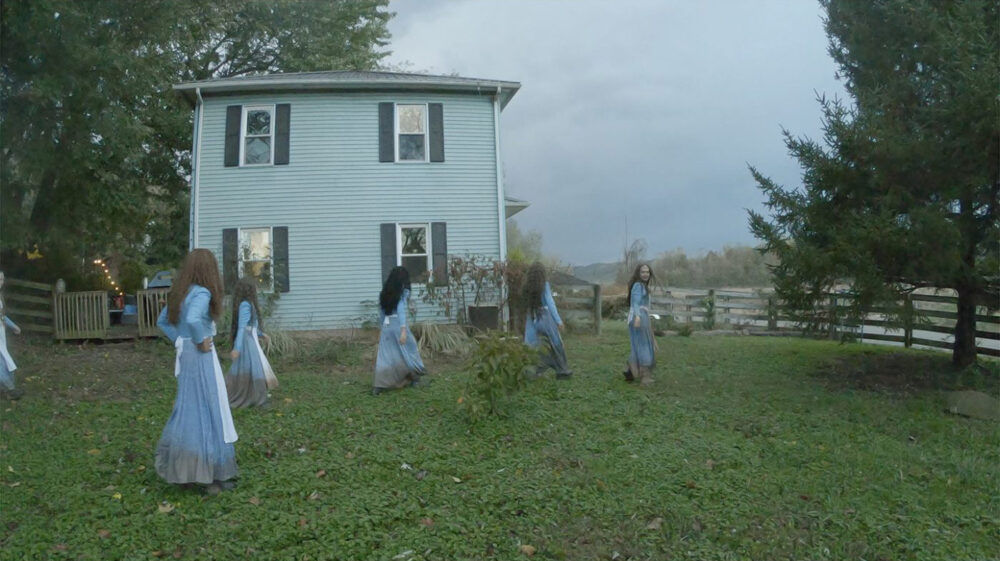
- Source: MOUSSE
- Author: Francesco Spampinato
- Date: APRIL 24, 2019
- Format: DIGITAL
Neighborhood Watch:
Lizzie Fitch and Ryan Trecartin

Production stills from work in progress, 2019. Photo: Fitch | Trecartin Studio
For their new exhibition Whether Line at Fondazione Prada, Milan, Lizzie Fitch and Ryan Trecartin present another of their uncanny “sculptural theaters,” a through route based on the movie set they built on the property near Athens, Ohio, where they moved in 2016 and where they have apparently settled down. This time they investigate an unmediated process of community bonding, based on the conflictive relationships they have established with their new neighbors—an advanced stage of their peculiar exploration of the schizophrenic effects of prosumer technologies and the internet.
In the beginning it was Providence, where Lizzie Fitch and Ryan Trecartin lived in the early 2000s as students at the Rhode Island School of Design. Then came New Orleans, Philadelphia, Miami, and Los Angeles, each selected as a temporary base for one of their peculiar movie projects, which are developed out of experiments in cohabitation with a community of co-conspirators. Perhaps in an attempt to reconnect with their homeland and families, perhaps moved by a desire to settle down, Fitch and Trecartin have decided to stop their whirlwind journey throughout the United States, at least for a while. They bought land in Ohio, where they grew up, specifically an area near Athens. With the support of Fondazione Prada, in 2016 they started building a movie set as two grown-up children, unprepared to face adulthood, would build a tree house to escape from reality—near the two homes where they live with their respective partners.
Bound by a long friendship that, over the years, has turned into a solid artistic partnership, Fitch and Trecartin wanted to make a set that, unlike the previous ones (which were destroyed after filming) would be permanent: the ultimate incarnation of that blurring of life and art that makes their productions so fascinating. Their choice to move to the Ohio countryside is motivated less by emotion than by an affinity with the back-to-the-land movement. A transhistorical phenomenon whose goal of self-sufficiency is based on growing food on a small-holding, the movement assumed the contours of an exodus in the United States in the late 1960s, when communities of hippies and dreamers left cities to embrace a lifestyle in communion with nature, in the countryside or the desert, epitomized by the construction of visionary, sustainable structures such as geodesic domes.
Depictions, speculations, and proper foundations of similar utopian lands and “imagi-nations” also recur in art history, with a significant comeback in contemporary practice. However, whereas for most artists these represent areas, geographic or virtual, freed by some sort of constriction, Fitch and Trecartin’s promised land has turned into a dystopian reality infested by the ghosts of Western civilization. What is at stake are the processes of community bonding, both internal (that is, the artists and their cohort) and with outsiders (namely, the actual neighbors, with whom the group has reportedly established a conflictive relationship). This is why the set looks more like a concentration camp than a paradise on Earth: a panoptical environment, self-contained within a forest, topped with a watchtower and developed around a massive swimming pool and a Frankenstein building made of elements of prefab houses, which the artists call respectively “the lazy river” and “the barn.”
The plot is based on a loose script, partly improvised and infiltrated by real-life elements. Mixing references and codes from fairy tales, commercial cinema, reality TV shows, and American history in the popular imagination, the movie tells of the vicissitudes occurring between a group of “queer people,” as the artists refer to them, and a wicked Amish neighbor girl—performed by Trecartin—joined by a group of clones. As spectators we are used to the artists’ representation of queerness as an alien type of nature, mostly via a carnivalesque abuse of makeup and costumes. What really strikes us is the way Amish culture—peaceful and based on simple living, farming, and the shunning of technology—is overturned into an incubator of frustration, alienation, and grudges against outsiders. The 2014 horror movie The Devil’s Hand, the story of a Satanic prophecy involving five Amish girls, comes to mind, as does The Blair Witch Project (1999), an early model of prosumer culture that is an ongoing source of inspiration for Fitch and Trecartin.
Along with pop culture, visual arts are a reference. Think of Henry Darger’s early twentieth-century illustrated saga of the Vivian Girls, a paradigmatic example of outsider art, which tells the story of seven girls from the imaginary nation of Abbieannia who rescue enslaved children. Their innocent and unapologetic behavior is echoed in Fitch and Trecartin’s Amish girl, who, in her blue church dress with white apron, incinerates a Christmas tree with a flamethrower. Another possible reference is Paul McCarthy and Mike Kelley’s project Heidi (1992), which addressed the eponymous children’s novel from a psychosexual angle, through a film and an installation of its prefabricated set and props. Similarly, Fitch and Trecartin’s exhibition Whether Line (2019), at Fondazione Prada, Milan, is an uncanny replica of the Athens set interspersed with clips of the movie, another of the artists’ “sculptural theaters” eliciting a reflection on how (social) media fantasies affect our increasingly precodified lifestyle and surroundings.

